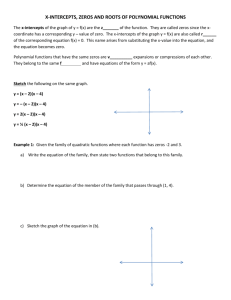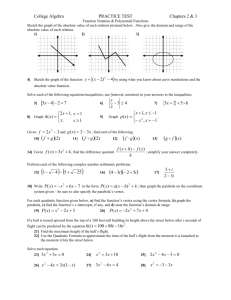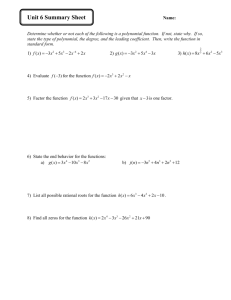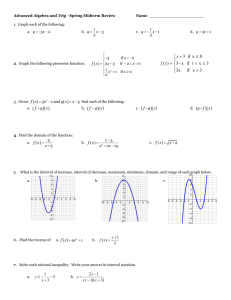0 Unit 2A Packet
advertisement
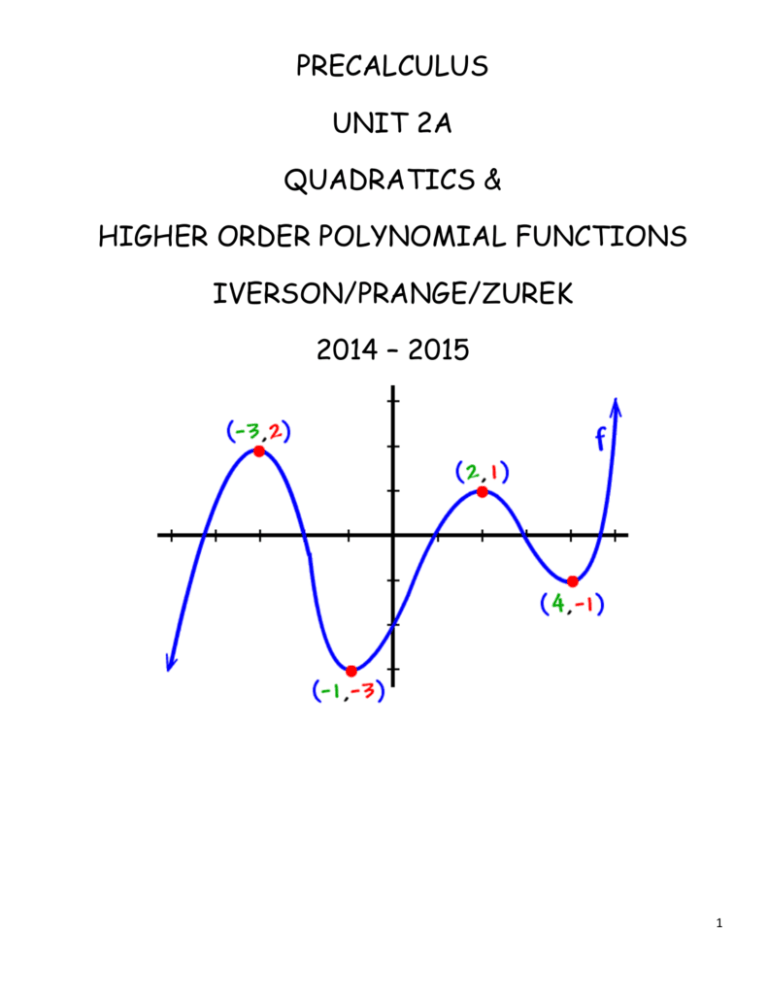
PRECALCULUS UNIT 2A QUADRATICS & HIGHER ORDER POLYNOMIAL FUNCTIONS IVERSON/PRANGE/ZUREK 2014 – 2015 1 Blank page 2 Learning Target Practice for the Learning Target 2.1.1 I can find the x-intercepts and/or vertex of a parabola using a graphing utility. Pg 95 17, 18, 19, 20 2.1.2 I can write the equation of a parabola given the x-intercepts and/or vertex. Pg 95 39, 40, 53,55 2.1.3 2.1.4 I can describe the meaning of a parabola's x-intercepts in a real world situation. I can describe the meaning a parabola's minimum or maximum in a real world situation. 2.8.1 I can find the quadratic regression equation given a set of points. 2.8.2 I can analyze, interpret, and predict using the quadratic regression equation. 2.2.1 2.2.2 I can determine the end behavior of a polynomial given the function and describe it using limit notation. I can determine the degree of the polynomial given the graph. Score on Learning Target Quiz Help needed? yes/no Pg 95 63 Pg 95 64, 65, 67 Pg 165 13, 14, 22, 23 Same as above problems Pg 109 17-21 all Pg 108 1-8 all 2.2.3 I can find the zeros of a higher order polynomial. 2.2.4 I can determine the relative and absolute extremes of a function. 2.2.5 I can use characteristics of a polynomial to sketch its graph. Pg 109 53, 55,61,63,65 2.2.6 I can apply my knowledge of polynomials to real world situations. Pg 110 85 2.3.1 I can use synthetic division to find factors and x-intercepts. Pg 124 35, 36, 38, 39, 41 2.3.2 I can use the graphing calculator to solve polymonial functions Pg 124 51, 52, 63 2.5.1 I can write a polynomial given its zeros. (will include real and imaginary) Pg 141 35, 36 2.5.2 I can find ALL real and imaginary zeros of a polynomial function. Pg 140 1, 3, 11, 13, 15, 19, 25, 45, 48 Pg 109 31, 32, 33 Pg 109 47, 49 3 Essential Questions for the chapter 1. In a polynomial function, how are factors, roots, zeros and x-intercepts related? 2. How do polynomial functions model real-world problems and their solutions? 3. Why are complex numbers necessary? 4. How are operations and properties of complex numbers related to those of real numbers? 5. Why are there asymptotes and holes in graphs of rational functions? 6. How do rational functions model real-world problems and their solutions? Essential Questions for the course 1. How is this similar or different from what I have done before? 2. What can I do to retain what I have learned? 3. Does my answer make sense? If not, what do I do? 4. Do I need help, and where do I go to find it? 5. How would a calculator make this problem easier to do? 6. How do I explain or justify my work to myself and others? 7. What is the given information and how do I use it? 4 LEARNING TARGET QUIZ SCORING RUBRIC A+ MASTERY (+) 100% I completely understand the strategy and mathematical operations to be used, and I used them or correctly. I did all of my calculations correctly. 4.0 My work shows what I did and what I was thinking while I worked the problem. The way I worked the problem makes sense and is easy for someone else to follow. I followed through with my strategy from beginning to end. My work was clear and organized. M92% or 3.7 MASTERY (-) I completely understand the strategy and mathematical operations to be used, but one minor error kept me completing the problem correctly. DM 85% or 3.4 DEVELOPING MASTERY I understand the strategy and mathematical operations to be used, but a few minor errors kept me from completing the problem correctly. My thought process was correct but one minor error kept me from getting the correct answer, BUT: o The way I worked the problem makes sense and is easy for someone else to follow. o I followed through with my strategy from beginning to end. o My work was clear and organized. I understood the concept, but my work lacks a few minor elements that would have made my thought process easy for anyone to follow. My thought process was correct but a few minor errors kept me from getting the correct answer. BU 75% or 3 BASIC UNDERSTANDING I used mathematical operations and a strategy that I think works for most of the problem. IU 50% or 2 INCOMPLETE UNDERSTANDING I wasn’t sure which mathematical operations to use, and my plan didn’t work. NE 0% or 0 NO EVIDENCE I did not demonstrate any understanding of the concept. My work included an obvious conceptual mistake. Several elements need to be added for my work to be easy to follow. I know which operations I should have used, but couldn’t complete the problem. I’m not sure how much detail I need in order to help someone understand what I did. I made several significant calculation errors. I tried several things related to the learning target(s), but didn’t get anywhere. I was not able to reach an answer. I left the problem blank. I didn’t know how to begin. I don’t know what to write. I wrote down information not related to the learning target(s). 5 AAT Review 1. What is the quadratic formula? 2 2. Solve 2 x 4 x 5 0 using the quadratic formula. (Of course use the program if you have it) 3. What information can the quadratic formula tell us about a given equation? 4. Write the ordered pairs that represent the zeros (or roots) and the vertex on the graph below then state the domain and range of the function in interval notation: Zeros: Vertex: Domain: Range: 5. Factoring is another way to find the zeros of a function. Find the error that Lina and Kristin have made when solving x 2 x 8 . 2 Lina x 2x 8 x( x 2) 8 x 8 or x 2 8 x6 2 Kristin x 2x 8 x2 2 x 8 0 x 4 x 2 0 x 4 0 or x 2 0 or x 2 x4 2 Lina didn’t __________________ Kristin should have ___________________ ___________________________ ___________________________________ Correct procedure and solutions: 6 6. Factor the following: a) 𝑥 2 − 9𝑥 + 14 b) 2𝑥 2 − 𝑥 − 3 Standard Form vs. Vertex Form: Parent Function: 𝑓(𝑥) = 𝑥 2 Standard form of a quadratic function: Vertex form of a quadratic function: 1 𝑓(𝑥) = 2𝑥 2 − 8𝑥 + 5 𝑓(𝑥) = − 2 (𝑥 − 3)2 + 2 Vertex: Vertex: Axis of Symmetry: Axis of Symmetry: Narrow or Wide: Narrow or Wide: Up or Down: Up or Down: Domain: Domain: Range: Range: 7 You try: State the vertex, the equation of the axis of symmetry, the direction the parabolas open and if they are narrower or wider than the parent function then sketch the graph: a) 𝑓(𝑥) = 2𝑥 2 + 8𝑥 + 7 b) 𝑓(𝑥) = −5(𝑥 − 3)2 + 6 Vertex: Vertex: Axis of Symmetry: Axis of Symmetry: Narrow or Wide: Narrow or Wide: Up or Down: Up or Down: Domain: Domain: Range: Range: 8 Date _______ Notes: 2.1 Essential Questions: 1. In a polynomial function, how are factors, roots, zeros and x-intercepts related? 2. How do polynomial functions model real-world problems and their solutions? Learning Targets: 2.1.1 I can find the x-intercepts and/or vertex of a parabola using a graphing utility. 2.1.2 I can write the equation of a parabola given the x-intercepts and/or vertex. 2.1.3 I can describe the meaning of a parabola's x-intercepts in a real world situation. 2.1.4 I can describe the meaning a parabola's minimum or maximum in a real world situation. Example 1: a) Write an equation given roots x = 2 and x = 7 where a, b, and c are integers. (Hint: Work backwards) b) Write an equation given roots x = ½ and -5 where a, b, and c are integers. c) Write an equation given vertex of (1, 2) that passes through the point (3, -6). 9 You try: a) Write a quadratic equation which has roots of 3 2 and -2. Write the equation in the form ax bx c 0 , where a, b, and c are integers. 2 b) Write an equation given vertex of (1, -4) that passes through the point (-2, 2). Example 2: Determine the vertices and x-intercepts for the following using your graphing utility: Round to the thousandths place. Then state if the parabola opens up or down and if it is narrower or wider than the parent function. a) 𝑓(𝑥) = −3𝑥 2 − 5𝑥 + 7 1 b) 𝑓(𝑥) = 2 𝑥 2 + 4𝑥 + 1 You try: Determine the vertices and x-intercepts for the following using your graphing utility: Round to the thousandths place. Then state if the parabola opens up or down and if it is narrower or wider than the parent function. 𝑓(𝑥) = 7𝑥 2 + 2𝑥 − 3 10 Example 3: You and your friends become entrepreneurs and start a company. When you first start, you have $20,000 debt due to start-up costs. Your company does well for a while, but peaks after 5 years with a profit of $100,000. Then, your profits start decreasing. Assuming this scenario is represented by a parabola (‘x’ in years, ‘y’ is profit in thousands of $), answer the following questions/statements: a. Write an equation to represent this situation. b. Assuming you don’t improve your situation, after how long would you be back to no profit? Example 4: Your friends start a company very different than yours. Right away the company has an amazing profit, but shortly after such immediate success, profits start declining. After some time, profits start going back up. The graph of the company’s profits can be represented by f ( x) 2 x 2 18x 50 . a. What are the profits immediately after the company is started? b. What is the lowest the profits go, and how long does it take for the profits to go that low? c. When would the profits from both companies be the same? What would the profits be? 11 Example 5: Each side of a square is lengthened by 2 inches. The area of this new, larger square is 64 inches. Find the length of a side of the original square. 2.1 PRACTICE Page 95 17-20, 39, 40, 53, 55, 63, 64, 65, 67 12 2.1 PRACTICE Page 95 17-20, 39, 40, 53, 55, 63, 64, 65, 67 13 2.1 PRACTICE (Cont.) Page 95 17-20, 39, 40, 53, 55, 63, 64, 65, 67 14 2.1 REVIEW WARM UP 1. Find the zeros of each function by factoring. 2 A. x 12 x 35 B. 3x 2 16 x 5 0 3. Using your calculator answer the following for f ( x) 4 x 2 x 5 . Round to three decimal places if necessary. 2 A. State the coordinates of the vertex. B. State the x-intercepts (zeros) of the function. C. State the max/min value of the function. D. State the equation of the Axis of Symmetry 15 2.1 REVIEW Calculator Portion. YOU MUST SHOW YOUR WORK TO RECEIVE CREDIT! Solve the following quadratic functions by graphing on the calculator. Round to the nearest hundredth if necessary and only give real solutions. 1. f ( x) x 2 7 x 8 1. ________________ Solve the following quadratic functions by factoring. 2. f ( x) x 2 15x 14 2. ________________ Solve the following quadratic functions by the quadratic formula. 3. f ( x) 2 x 2 3x 5 3. ________________ Using your graphing calculator, analyze the following quadratic functions. Find the vertex, line of symmetry, domain (interval notation), range (interval notation), zeros (x-intercepts), and is the vertex at a minimum or maximum at what y-value. Round to the nearest hundredth if necessary. f ( x) x 2 7 x 4 4. vertex _______________ 5. line of sym. ___________ 6. domain ______________ 7. range ________________ 8. zeros ________________ 9. min/max at y = ________ (circle one) 10. A gymnast dismounts the uneven parallel bars at a height of 8 feet with an initial upward velocity of 8 feet per second. The function 𝑠(𝑡) = −16𝑡 2 + 8𝑡 + 8 descries the height of the gymnast’s feet above the ground, 𝑠(𝑡), in feet, t, seconds after dismounting. A. How long will it take the gymnast to reach the ground? B. When will the gymnast be 8 feet above the ground? 16 11. Each side of a square is lengthened by 3 inches. The area of this new, larger square is 36 inches. Find the length of a side of the original square. 12. A patio measuring 15 meters by 25 meters is surrounded by a planting bed of uniform width. If the area of the patio and planting bed combined is 500 square meters, what is the width of the planting bed? Patio 13. The figure shows that when a football is kicked, the nearest defensive player is 6 feet from the point of impact with the kicker’s foot. The height of the punted football, 𝑓(𝑥), in feet, can be modeled by 𝑓(𝑥) = −.01𝑥 2 + 1.18𝑥 + 2, where x is the ball’s horizontal distance, in feet, from the point of impact with the kicker’s foot. A. What is the maximum height of the punt and how far from the point of impact does this occur? B. How far must the nearest defensive player, who is 6 feet from the kicker’s point of impact, reach to block the punt? C. If the ball is not blocked by the defensive player, how far down the field will it go before hitting the ground? D. Describe the meaning of the y-intercept in this scenario. 17 2.1 REVIEW Non-calculator Portion Sketch the graphs. Label your vertex. 14. y x 4 6 2 15. y x 2 3 2 16. y x 5 1 2 Write the equation for the graphs in standard form 𝑓(𝑥) = 𝑎𝑥 2 + 𝑏𝑥 + 𝑐: 17. ________________________ 18. ______________________ 18 Date _______ Notes: 2-8 Essential Questions: 1. How do polynomial functions model real-world problems and their solutions? Learning Targets: 2.8.1 I can find the quadratic regression equation given a set of points. 2.8.2 I can analyze, interpret, and predict using the quadratic regression equation. WARM UP Falling Object: In an experiment, students measured the speed “s” (in meters per second) of a ball “t” seconds after it was released. The results are shown in the table. Time, t Speed, s 0 0 1 11.0 2 19.4 3 4 29.2 39.4 a) Use your graphing utility to create the scatter plot. b) Find the linear equation for this data. c) What is the interpretation of the slope? d) Estimate what the speed of the ball was after 2.5 seconds. 19 Ex1: Classifying Scatter Plots: Working with a partner, please enter the data below. Person 1 will enter the data from “a” and person 2 will enter the data from ‘b”. Display your scatter plots and decide whether each set of data could best be modeled by a linear model, y=ax+b or a quadratic model, y=ax2+bx+c. a. (0.9, 1.4) (1.3, 1.5) (1.3, 1.9) (1.4, 2.1) (1.6, 2.8) (1.8, 2.9) (2.1, 3.4) (2.1, 3.4) (2.5, 3.6) (2.9, 3.7) (3.2, 4.2) (3.3, 4.3) (3.6, 4.4) (4.0, 4.5) (4.2, 4.8) (4.3, 5.0) b. (0.9, 2.5) (1.3, 4.03) (1.3, 4.1) (1.4, 4.4) (1.6, 5.1) (1.8, 6.05) (2.1, 7.48) (2.1, 7.6) (2.5, 9.8) (2.9, 12.4) (3.2, 14.3) (3.3, 15.2) (3.6, 18.1) (4.0, 19.9) (4.2, 23.0) (4.3, 23.9) Ex2: Fitting a Quadratic Model to Data: A study was done to compare the speed “x” ( in miles per hour) with the mileage “y” (in miles per gallon) of an automobile. The results are shown in the table. SPEED, x 15 20 25 30 35 40 45 50 55 60 65 70 75 MILEAGE, y 22.3 25.5 27.5 29.0 28.8 30.0 29.9 30.2 30.4 28.8 27.4 25.3 23.3 a. Use a graphing utility to create a scatter plot of the data. b. Does the data look linear or quadratic? Use the regression feature of the graphing utility to find the regression equation. Graph the function in the same window as your scatter plot. c. Approximate the speed at which the mileage is the greatest. 20 Ex3: PARTNER PROBLEM: A basketball is dropped from a height of about 5.25 feet. The height of the basketball is recorded 23 times at intervals of about 0.02 seconds. The results are shown in the table. Use a graphing utility to find a model that best fits the data. Then use the model to predict the time when the basketball will hit the ground. TIME, x 0.0 0.02 0.04 0.06 0.08 0.099996 0.1199966 0.139992 0.159988 0.179988 0.199984 0.219984 0.23998 0.25993 0.27998 0.299976 0.319972 0.339961 0.359961 0.379951 0.399941 0.419941 0.439941 2.8 PRACTICE HEIGHT, y 5.23594 5.20353 5.16031 5.09910 5.02707 4.95146 4.85062 4.74979 4.63096 4.50132 4.35728 4.19523 4.02958 3.84593 3.65507 3.44981 3.23375 3.01048 2.76921 2.52074 2.25786 1.98058 1.63488 Page 165 13, 14, 15, 23 21 2.8 PRACTICE Page 165 13, 14, 15, 23 22 Date _______ Notes: 2-2 (Day 1) Essential Questions: 1. In a polynomial function, how are factors, roots, zeros and x-intercepts related? 2. How do polynomial functions model real-world problems and their solutions? Learning Targets: 2.2.1 I can determine the end behavior of a polynomial given the function and describe it using limit notation. 2.2.2 I can determine the degree of the polynomial given the graph. 2.2.3 I can find the zeros of a higher order polynomial. 2.2.4 I can determine the relative and absolute extremes of a function. 2.2.5 I can use characteristics of a polynomial to sketch its graph 2.2.6 I can apply my knowledge of polynomials to real world situations. Warm Up: 1. Find the zeros of each function by factoring. a) x2 12 x 35 c) x 4 x3 6 x 2 0 b) 3x 2 12 x 10 2 2. Use your calculator to find the relative maximums and/or minimums for c) above. 23 Notes: Polynomial functions are continuous (no breaks, holes, sharp turns or gaps). Examples of continuous polynomial functions: Examples of non-continuous polynomial functions: ______________ ______________ _______________ ______________ 24 Polynomials: Degree of a polynomial: Ex: y 4 x x 1 3 2 The degree of the polynomials determines _____________________________________. Relative maxima and minima: Absolute maximum and minimum: Leading Coefficient: Ex: y 4 x x 1 3 2 Names of polynomial functions: Name Degree Example Shape Linear Quadratic Cubic Quartic Quintic 25 End Behavior of Polynomial Functions: Ex 1) Look at the equations and graphs below. See if you can identify a pattern relating the leading coefficient and polynomial degree to the end behavior of the function. f ( x) x 4 1 f ( x) x 4 5 x 2 4 Leading Coefficient Test: f ( x) 2 x 4 2 x 2 f ( x) 5 7 x 3x 2 2 f ( x) a n x n .... a1 x a 0 When n is even: a n is positive: a n is negative: 26 Ex 2) Look at the leading coefficient/degree and determine how it affects end behavior. f ( x) x 3 f ( x) x 7 3 x 3 x 2 1 Leading Coefficient Test: f ( x) x 3 4 x f ( x) x 5 4 x 2 f ( x) a n x n .... a1 x a 0 When n is odd: a n is positive: a n is negative: 27 Ex 3) Using the rules defined on the previous page, predict the end behavior of the following functions: A) y 3x2 3x 9 Degree: B) y 5x4 3x3 7 x2 9x 5 Degree: Leading Coefficient: Leading Coefficient: End Behavior: End Behavior: C) y 6x3 9x2 7 x 10 Degree: D) y 5x5 17 x4 21x3 2x2 x 7 Degree: Leading Coefficient: Leading Coefficient: End Behavior: End Behavior: 2.2 Day 1 PRACTICE Page 108 1-8, Added directions: Please state the domain and range for #1-8 17, 18, 19, 20, 21 28 2.2 Day 1 PRACTICE Page 108 1-8, Added directions: Please state the domain and range for #1-8 17, 18, 19, 20, 21 29 Date _______ Notes: 2-2 (Day 2) Essential Questions: In a polynomial function, how are factors, roots, zeros and x-intercepts related? 1. In a polynomial function, how are factors, roots, zeros and x-intercepts related? 2. How do polynomial functions model real-world problems and their solutions? Learning Targets: 2.2.1 I can determine the end behavior of a polynomial given the function and describe it using limit notation. 2.2.2 I can determine the degree of the polynomial given the graph. 2.2.3 I can find the zeros of a higher order polynomial. 2.2.4 I can determine the relative and absolute extremes of a function. 2.2.5 I can use characteristics of a polynomial to sketch its graph 2.2.6 I can apply my knowledge of polynomials to real world situations. WARM UP 1. Find the zeros of each function then SKETCH the graphs using this information (sketches do not have to be extremely accurate). x3 2 x 2 3 x3 3x 2 x 3 x 4 x3 6 x 2 2. How does the degree relate to the number of zeros a function has? 30 Example 1 Solve the following by factoring (review/practice). A. f ( x) x 2 9 B. f ( x) x3 x 2 6 x C. f ( x) x 16 x 64 x 3 2 Example 2 Write a polynomial function in factored form given its zeros. A. x -2, 3, and 3 B. x -4, -2, and 0 Multiplicity of a zero: If a zero is repeated, it is said to have ___________________. For example, in the equation 𝑓(𝑥) = (𝑥 + 3)(𝑥 + 3), the only zero is 𝑥 = −3. This zero, however, occurs twice. So we say this zero has a multiplicity of _____. Graphically, a repeated zero causes a _______________ in the graph. 31 Example 3 In each item below, identify the multiplicity of each root. B. y x 2 x 1 x 1 A. x -2, 3, and 3 C. y x 1 x 2 2 2 x 4 5 Using information about the graph’s end behavior, the x-intercepts (roots) and their multiplicity, it is possible to sketch the graph of most polynomials. 1. Use end behavior to determine where the graph starts and ends. 2. Each x-intercept that has odd multiplicity (single root) represents a place where the graph crosses the x-axis. 3. Each x-intercept with even multiplicity represents a place where the graph will “bounce” (touch the x-axis and immediately change direction). Example 4: Sketch the graph of 𝑓(𝑥) = 𝑥 4 − 𝑥 3 − 2𝑥 2 End behavior: x-intercepts: Absolute Extremes? 32 Example 5: Sketch the graph of: 𝑓(𝑥) = 𝑥 3 + 2𝑥 2 − 4𝑥 − 8 End behavior: x-intercepts: Absolute Extremes? Example 6: Sketch the graph of: 𝑓(𝑥) = 3𝑥 4 − 48𝑥 2 End behavior: x-intercepts: Absolute Extremes? 33 Show and discuss website http://math.stackexchange.com/questions/83837/what-is-a-real-world-applicationof-polynomial-factoring Example 7 Application: Environment: The growth of a red oak tree is approximated by the function G 0.003t 3 0.137t 2 0.458t 0.839 Where G is the height of the tree (in feet) and t (2 t 34) is the age (in years). Use a graphing utility to graph the function. A. What is the independent variable in the context of the problem? Do negative x-values make sense? B. Zoom out to see the full function. Approximate the x-values that will be our focus. What is happening when G = 0? C. Approximate the age of the tree when the growth rate has maximized. 34 Example 8 An open box with locking tabs is to be made from a square piece of material 24 inches on a side. This is done by cutting equal squares form the corners and folding along the dashed line, as shown in the figure. A. Verify that the volume of the box is given by the function 𝑉(𝑥) = 8𝑥(6 − 𝑥)(12 − 𝑥). B. Determine the domain of the function V. C. Sketch the graph of the function and estimate the value of 𝑥 for which 𝑉(𝑥) is maximum. 2.2 PRACTICE Page 109 31, 53, 55, 61, 62, 65, 85 35 2.2 PRACTICE Page 109 31, 53, 55, 61, 62, 65, 85 36 Date _______ Notes: 2.3 Day 1 Essential Questions: 1. In a polynomial function, how are factors, roots, zeros and x-intercepts related? Learning Targets: 1.3.1 I can use synthetic division to find factors and x-intercepts. 1.3.2 I can use the graphing calculator to solve polynomial functions. AAT – Review - Synthetic Division: Divide the polynomials below using synthetic division: 1. 𝑓(𝑥) = 3𝑥 3 + 8𝑥 2 + 5𝑥 − 7 by 𝑥 + 2 2. 𝑓(𝑥) = 2𝑥 3 − 15𝑥 2 + 27𝑥 − 10 by 𝑥 − 2 1 You try: 𝑓(𝑥) = 6𝑥 3 − 19𝑥 2 + 16𝑥 − 4 by 𝑥 − 2 37 The FACTOR Theorem: ______________________________________________________________________ ______________________________________________________________________ ______________________________________________________________________ ______________________________________________________________________ Example 1: Use synthetic division to show x is a solution of the third degree polynomial. Use the result to factor the polynomial & find the remaining real zeros. List all real zeros. a) x3 2 x 2 5 x 6 x 1 3 b) x 28 x 48 0 x 4 38 Example 2: 1) Verify the given factors of the function. 2) Find the remaining factors of the function. 3) Write the complete factorization of the function. 4) List the real zeros. a) f ( x) 3x3 2 x 2 19 x 6 b) f ( x) 8x 4 14 x3 71x 2 10 x 24 Factors ( x 3), ( x 2) Factors ( x 2), ( x 4) Vocabulary Summary: 1. (x – 4) is a factor of f(x), then ________________________ is a zero of f(x). 2. If (-2, 0) is an x-intercept, then _________________________ is a factor of f(x). 3. If x = 5 is a solution of f(x) = 0, then _____________________ is a factor of f(x). 4. If (x – a) is a factor of f(x), then ________________________is a zero of f(x). 5. If (a, 0) is an x-intercept, then _____________________ is a factor of f(x). 6. If x = a is a solution of f(x) = 0, then ____________________ is a factor of f(x). 2.3 PRACTICE Page 124 35, 36, 38, 39, 41 39 2.3 PRACTICE Page 124 35, 36, 38, 39, 41 40 Date _______ Notes: 2-3 Day 2 Essential Questions: 1. In a polynomial function, how are factors, roots, zeros and x-intercepts related? Learning Targets: 2.3.1 I can use synthetic division to find factors and x-intercepts. 2.3.2 I can use the graphing calculator to solve polynomial functions. WARM UP 1. Prove that x 2 and x 3 are factors of the polynomial below using synthetic division. 2 x4 7 x3 4 x 2 27 x 18 a) √−9 2. Simplify: 3. Solve 3𝑥 2 + 48 = 0 b) √−28 c) √−32 41 Example 1 Find all real solutions of the polynomial equations using the following steps. 1. First, try to factor the equation. 2. Find one “nice” (integer) zero on your calculator 3. Simplify further by performing one or more of the following: a. Quadratic formula b. Factoring c. Synthetic division A. f ( x) 3x 20 x 36 x 16 3 2 (You Try) B. f ( x) 2 x 3x 8 x 3 3 2 C. f ( x) x x 29 x x 30 4 3 2 2.3 Day 2 PRACTICE Page 124 51, 52, and 63 (find the zeros only for 63) 42 2.3 Day 2 PRACTICE Page 124 51, 52, and 63 (find the zeros only for 63) 43 REVIEW (2.2 to 2.3) 1. For each item below, identify the end behavior, the number of zeroes and the maximum number of curves that graph may have. (NO CALC) End Behavior Number of Zeroes Max. number of curves possible in the graph 𝑓(𝑥) = −3𝑥 5 + 7𝑥 4 + 2𝑥 3 − 19 𝑔(𝑥) = 4𝑥12 − 8𝑥11 ℎ(𝑡) = −7𝑡 4 + 6𝑡 7 − 8𝑡 2 2. Determine whether the graph at the right represents an odd or even-degree polynomial, if the leading coefficient is positive or negative, and then state the number of real zeros. (NO CALC) Circle the correct answer for a - c: a) The degree is: Even or Odd b) Leading Coef:Positive or Negative c) # of Real Zeros: 1 2 3 Draw a graph that could resemble a function with the following characteristics: 3. 4. A 4th degree polynomial with a negative lead coefficient and 3 real zeros. A 5th degree polynomial with a positive lead coefficient and 1 real zero. 44 4. Find all the zeroes of the following by factoring (NO CALCULATOR) a. 𝑔(𝑥) = 𝑥 2 − 7𝑥 + 10 b. 𝑔(𝑥) = 𝑥 3 +14𝑥 2 + 33𝑥 c. 𝑔(𝑥) = 𝑥 3 + 2𝑥 2 − 4𝑥 − 8 For 5 and 6, divide using long division. If it divides evenly, find all the zeroes for the original equation 5. 𝑓(𝑥) = 𝑥 4 − 3𝑥 3 + 2𝑥 + 7 ÷ (𝑥 2 + 𝑥) 6. 𝑓(𝑥) = 𝑥 4 + 𝑥 3 − 9𝑥 2 − 9𝑥 ÷ (𝑥 2 − 9) 45 For 7-8, divide using synthetic division. If it divides evenly, find all the zeroes for the original equation. 7. 𝑓(𝑥) = 𝑥 3 + 7𝑥 2 + 8𝑥 − 16 ÷ (𝑥 − 1) 9. One factor of x3 x 2 14 x 24 is ( x 4). Find the remaining factors. For problems 10 – 11 find all of the zeroes. 10. f x x3 5x2 8x 6 8. 𝑓(𝑥) = 2𝑥 3 + 4𝑥 2 − 8𝑥 + 2 ÷ (𝑥 + 3) 9. x 4 , _________________________ 10. ___________________________ 46 11. f x 2x4 5x3 3x2 4x 6 11. ___________________________ For each function, identify the degree, leading coefficient, end behavior and zeroes. Then graph the function. 12. 13. 𝑓(𝑥) = 𝑥 3 + 4𝑥 2 + 4𝑥 𝑔(𝑥) = 𝑥 4 − 9𝑥 2 Degree: ____________________ Leading Coeff: _______________ End behavior:________________ Zeroes: _____________________ Degree: ____________________ Leading Coeff: _______________ End behavior:________________ Zeroes: _____________________ 47 Date _______ Notes: 2-5 Essential Questions: 1. In a polynomial function, how are factors, roots, zeros and x-intercepts related? 2. Why are complex numbers necessary? Learning Targets: 2.5.1 I can write a polynomial give its zeros. (will include real and imaginary) 2.5.2 I can find ALL real and imaginary zeros of a polynomial function. AAT Review – Complex numbers Complex Conjugate: Find the complex conjugate: a) 4 3i b) 2 2i c) 6i d) Multiply 3 5i by its conjugate Example 1 Find all zeros & write the polynomial as a product of linear factors. To begin, always try to factor first, then try quadratic formula, and finally try to find an integer zero on the calculator. A) f ( x) x 4 6 x3 10 x 2 6 x 9 B) f ( x) x3 4 x 2 14 x 20 48 What do you notice about the complex zeros from the above examples? _____________________________________________________________________________ Complex zeros occur in __________________________________________________________ _____________________________________________________________________________ Find all of the zeros for 𝑓(𝑥) = 𝑥 3 − 7𝑥 2 − 𝑥 + 87 if one zero is 5 + 2𝑖. Example 2 Find a polynomial function in standard form with integer coefficients. A) x = 3, 5, 0, 0 B) 𝑥 = −2, 3𝑖 You Try: 𝑥 = 3, 4𝑖 2.5 PRACTICE Page 140-141 1, 3, 11, 13, 15, 19, 25, 35, 36, 45, 48 49 2.5 PRACTICE Page 140-141 1, 3, 11, 13, 15, 19, 25, 35, 36, 45, 48 50 2.5 PRACTICE (cont.) Page 140-141 1, 3, 11, 13, 15, 19, 25, 35, 36, 45, 48 51


